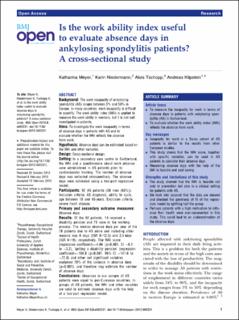Please use this identifier to cite or link to this item:
https://doi.org/10.21256/zhaw-3831Full metadata record
| DC Field | Value | Language |
|---|---|---|
| dc.contributor.author | Meyer, Katharina | - |
| dc.contributor.author | Niedermann Schneider, Karin | - |
| dc.contributor.author | Tschopp, Alois | - |
| dc.contributor.author | Klipstein, Andreas | - |
| dc.date.accessioned | 2018-07-05T13:48:38Z | - |
| dc.date.available | 2018-07-05T13:48:38Z | - |
| dc.date.issued | 2013 | - |
| dc.identifier.issn | 2044-6055 | de_CH |
| dc.identifier.uri | https://digitalcollection.zhaw.ch/handle/11475/7595 | - |
| dc.description.abstract | Background: The work incapacity of ankylosing spondylitis (AS) ranges between 3% and 50% in Europe. In many countries, work incapacity is difficult to quantify. The work ability index (WAI) is applied to measure the work ability in workers, but it is not well investigated in patients. Aims: To investigate the work incapacity in terms of absence days in patients with AS and to evaluate whether the WAI reflects the absence from work. Hypothesis: Absence days can be estimated based on the WAI and other variables. Design: Cross-sectional design. Setting: In a secondary care centre in Switzerland, the WAI and a questionnaire about work absence were administered in AS patients prior to cardiovascular training. The number of absence days was collected retrospectively. The absence days were estimated using a two-part regression model. Participants: 92 AS patients (58 men (63%)). Inclusion criteria: AS diagnosis, ability to cycle, age between 18 and 65 years. Exclusion criteria: severe heart disease. Primary and secondary outcome measures: Absence days. Results: Of the 92 patients, 14 received a disability pension and 78 were in the working process. The median absence days per year of the 78 patients due to AS alone and including other reasons was 0 days (IQR 0–12.3) and 2.5 days (IQR 0–19), respectively. The WAI score (regression coefficient=−4.66 (p<0.001, CI −6.1 to −3.2), ‘getting a disability pension’ (regression coefficient=−106.8 (p<0.001, 95% CI −141.6 to −72.0) and other not significant variables explained 70% of the variance in absence days (p<0.001), and therefore may estimate the number of absence days. Conclusions: Absences in our sample of AS patients were equal to pan-European countries. In groups of AS patients, the WAI and other variables are valid to estimate absence days with the help of a two-part regression model. | de_CH |
| dc.language.iso | en | de_CH |
| dc.publisher | BMJ Publishing Group | de_CH |
| dc.relation.ispartof | BMJ Open | de_CH |
| dc.rights | http://creativecommons.org/licenses/by-nc/2.0/ | de_CH |
| dc.subject.ddc | 616.7: Krankheiten des Bewegungsapparates und Orthopädie | de_CH |
| dc.title | Is the work ability index useful to evaluate absence days in ankylosing spondylitis patients? : a cross-sectional study | de_CH |
| dc.type | Beitrag in wissenschaftlicher Zeitschrift | de_CH |
| dcterms.type | Text | de_CH |
| zhaw.departement | Gesundheit | de_CH |
| zhaw.organisationalunit | Institut für Physiotherapie (IPT) | de_CH |
| dc.identifier.doi | 10.21256/zhaw-3831 | - |
| dc.identifier.doi | 10.1136/bmjopen-2012-002231 | de_CH |
| zhaw.funding.eu | No | de_CH |
| zhaw.issue | e002231 | de_CH |
| zhaw.originated.zhaw | Yes | de_CH |
| zhaw.publication.status | publishedVersion | de_CH |
| zhaw.volume | 3 | de_CH |
| zhaw.publication.review | Peer review (Publikation) | de_CH |
| Appears in collections: | Publikationen Gesundheit | |
Files in This Item:
| File | Description | Size | Format | |
|---|---|---|---|---|
| 2013_Meyer K_Work_Ability_Index.pdf | 202.35 kB | Adobe PDF |  View/Open |
Show simple item record
Meyer, K., Niedermann Schneider, K., Tschopp, A., & Klipstein, A. (2013). Is the work ability index useful to evaluate absence days in ankylosing spondylitis patients? : a cross-sectional study. BMJ Open, 3(e002231). https://doi.org/10.21256/zhaw-3831
Meyer, K. et al. (2013) ‘Is the work ability index useful to evaluate absence days in ankylosing spondylitis patients? : a cross-sectional study’, BMJ Open, 3(e002231). Available at: https://doi.org/10.21256/zhaw-3831.
K. Meyer, K. Niedermann Schneider, A. Tschopp, and A. Klipstein, “Is the work ability index useful to evaluate absence days in ankylosing spondylitis patients? : a cross-sectional study,” BMJ Open, vol. 3, no. e002231, 2013, doi: 10.21256/zhaw-3831.
MEYER, Katharina, Karin NIEDERMANN SCHNEIDER, Alois TSCHOPP und Andreas KLIPSTEIN, 2013. Is the work ability index useful to evaluate absence days in ankylosing spondylitis patients? : a cross-sectional study. BMJ Open. 2013. Bd. 3, Nr. e002231. DOI 10.21256/zhaw-3831
Meyer, Katharina, Karin Niedermann Schneider, Alois Tschopp, and Andreas Klipstein. 2013. “Is the Work Ability Index Useful to Evaluate Absence Days in Ankylosing Spondylitis Patients? : A Cross-Sectional Study.” BMJ Open 3 (e002231). https://doi.org/10.21256/zhaw-3831.
Meyer, Katharina, et al. “Is the Work Ability Index Useful to Evaluate Absence Days in Ankylosing Spondylitis Patients? : A Cross-Sectional Study.” BMJ Open, vol. 3, no. e002231, 2013, https://doi.org/10.21256/zhaw-3831.
Items in DSpace are protected by copyright, with all rights reserved, unless otherwise indicated.